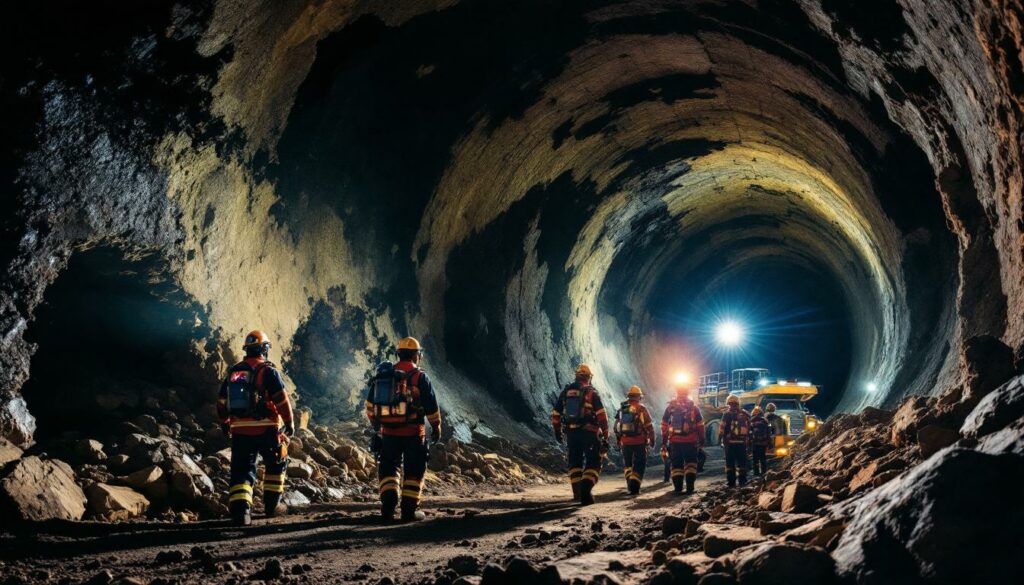What Happened at Grosvenor Mine?
The 2024 Explosion and Fire
On June 29, 2024, an underground methane ignition at Grosvenor mine triggered a major evacuation, marking the second significant incident at the mine in four years. The methane gas ignition created an underground inferno that forced immediate action to contain the blaze.
Black smoke plumes engulfed the town of Moranbah, forcing residents to stay indoors and keep their windows shut as authorities worked to control the situation. The severity of the smoke indicated the significant scale of the underground fire.
Mine operators took immediate action by sealing the mine shafts to starve the underground fire of oxygen – a standard but critical safety protocol during underground coal mine fires. This decisive action helped prevent the fire from worsening while ensuring no personnel remained underground.
Fortunately, no injuries were reported in this incident, unlike the 2020 explosion that seriously injured five workers at the same mine. The successful evacuation demonstrated improved emergency response protocols since the previous incident.
History of Safety Incidents
The June 2024 explosion represents the second major incident in four years at Grosvenor mine, establishing a concerning pattern of safety issues. The previous explosion in 2020 resulted in five workers suffering serious injuries, highlighting ongoing safety challenges at the operation.
This pattern extends beyond Grosvenor mine alone. The neighboring Moranbah North mine, also operated by Anglo American, experienced an underground fire in April 2024, just months before the Grosvenor incident. Both mines are located in Queensland's Bowen Basin, a region known for its metallurgical coal production.
The repeated incidents at multiple Anglo American operations have raised serious questions about safety culture, methane management protocols, and fire prevention strategies across the company's Queensland coal assets. Industry observers note that two major incidents at the same mine within four years is unusually high for modern mine planning standards.
Mining safety experts point out that methane management remains one of the most critical safety challenges in underground coal mining, requiring constant vigilance, advanced monitoring systems, and strict adherence to ventilation protocols.
How is the Mine Re-entry Being Conducted?
Initial Inspection Process
The first major step toward re-entry occurred on August 7, 2025, when a Queensland Mines Rescue Service team entered the mine for preliminary reconnaissance inspections and re-entry at Grosvenor mine. This carefully planned operation came after the mine had been sealed for over a year following the explosion.
The initial team consisted of specially trained mine rescue personnel who focused on assessing underground conditions to determine the extent of damage and potential safety hazards. Their observations would inform subsequent re-entry phases and recovery operations.
Inspectors wore advanced protective equipment and respirators to shield themselves from potential gas pockets, structural hazards, and other dangers that might be present in the mine environment. This protective gear is specially designed for post-incident mine exploration.
The entry followed a rigorous approval process from Queensland's resources safety regulator, which required detailed plans addressing potential hazards and mitigation strategies. This regulatory oversight ensures that re-entry operations prioritize worker safety above all else.
Safety Preparations
Extensive safety preparations were completed in the week leading up to the initial re-entry. Mine shafts were unsealed after being closed for over a year – a delicate operation requiring careful monitoring of gas levels and structural integrity.
Parts of the mine were systematically re-ventilated to create safe breathing environments and disperse potentially dangerous gas accumulations. This process uses specialized ventilation equipment and follows strict safety protocols developed specifically for post-fire mine recovery.
The Mining and Energy Union, which had previously imposed a ban on entry due to safety concerns, lifted its restrictions after reviewing the safety preparations and protocols. This union clearance represented a significant vote of confidence in the re-entry plan.
Mine General Manager Shane McDowall called the first re-entry a "significant milestone" in the recovery process, acknowledging the extensive work required to reach this point. His statement highlighted the importance of this step toward eventual resumption of operations.
Technical Challenges
One of the primary technical challenges facing the recovery team is the deterioration of mine shaft lining from fire damage. Mining and Energy Union representative Jason Hill specifically highlighted this concern, noting that the fire had damaged the surrounding structure.
Structural integrity concerns require continuous monitoring throughout the re-entry and recovery process. As Hill emphasized, "It's a matter of monitoring and ensuring that there were no issues that were going to pop up" – underscoring the unpredictable nature of post-fire mine conditions.
The recovery process has demanded innovative problem-solving and technology adaptation. Shane McDowall praised the mine crews who have "stepped up in amazing ways — solving problems, adapting technology in innovative ways, and rethinking how we do things underground."
Before staff can safely return to regular work, comprehensive safety inspections must be completed throughout accessible areas of the mine. These inspections will assess air quality, structural stability, equipment integrity, and other critical safety factors.
What are the Economic Impacts of the Mine Closure?
Financial Costs to Anglo American
The prolonged closure of both Grosvenor and Moranbah North mines has created substantial financial pressure for Anglo American. CEO Duncan Wanblad revealed that the company faces approximately $55 million in monthly expenditures to maintain both inactive mines.
This significant financial burden includes continued payment of staff despite the production halt – a decision that maintains workforce stability but weighs heavily on the company's balance sheet. The commitment to retain workers demonstrates Anglo American's long-term commitment to these operations.
Maintenance costs at both Grosvenor and Moranbah North mines constitute a significant portion of the monthly expenditure. These costs include essential systems monitoring, equipment preservation, structural maintenance, and security operations necessary to protect these valuable assets.
The extended closures potentially impact the $5.7 billion sale agreement with Peabody Energy, as operating mines command higher valuations than inactive ones. This financial reality creates strong incentives for Anglo American to safely restart operations as quickly as possible.
Timeline for Resuming Operations
Anglo American has communicated expectations that Grosvenor operations will restart "later this year" (2025), though specific dates remain dependent on inspection results and remediation progress. This timeline suggests confidence in addressing the critical safety issues.
The neighboring Moranbah North mine is projected to resume operations in 2026, indicating a longer recovery period for that facility. The staggered restart approach allows the company to focus resources on boosting safety operations at Grosvenor first.
While initial restart dates have been announced, the full production restart timeline remains uncertain and will depend on progressive inspection results and remediation efforts. The phased approach to recovery recognizes the complexity of safely reactivating underground coal mining operations.
Mining and Energy Union representative Jason Hill expressed skepticism about a quick return to full production, stating that while "there's nothing to say it can't return into a full production," success depends on "identifying what happened" and addressing root causes. This cautious perspective reflects the union's priority on worker safety.
How Does This Affect the Peabody Energy Acquisition?
Deal Contingencies and Complications
The $5.7 billion agreement signed in November 2024 between Anglo American and Peabody Energy covers the purchase of Anglo American's four steelmaking coal mines in Queensland. This major transaction represents significant changes in the ownership landscape of Queensland's coal sector.
A crucial contingency within the agreement makes restarting longwall mining at Grosvenor a condition affecting the final sale price. This stipulation creates direct financial incentives for Anglo American to achieve operational status before completing the transaction.
Complicating matters further, Peabody described the Moranbah North explosion as a "Material Adverse Change" to the deal – terminology that often allows parties to renegotiate terms or potentially exit agreements. This designation indicates the serious impact of the incident on deal valuation.
Peabody is expected to update their position on the deal later this month, creating a period of uncertainty for both companies, employees, and regional stakeholders. This forthcoming announcement will likely clarify whether the deal proceeds and under what modified terms.
Anglo American's Perspective
CEO Duncan Wanblad has publicly stated that "both companies still wanted the deal to go ahead," indicating Anglo American's continued commitment to completing the transaction despite the operational challenges. This positive messaging aims to maintain stakeholder confidence.
Wanblad acknowledged that the final decision "ultimately" belongs to Peabody, recognizing the acquiring company's prerogative to reassess terms based on changed conditions. This statement reflects the reality of Peabody's stronger negotiating position following the incidents.
Anglo American continues remediation efforts to fulfill sale conditions, demonstrating its commitment to transferring operational mines rather than idled assets. These efforts represent significant investments aimed at preserving deal value.
The strategic importance of resolving operational issues before transfer remains paramount for Anglo American, as it directly impacts the final valuation and successful completion of the $5.7 billion transaction. This financial reality drives the company's aggressive timeline for mine recovery.
What Safety Measures are Being Implemented?
Advanced Monitoring Systems
Continuous assessment of structural integrity forms the foundation of the safety approach during re-entry. As Jason Hill noted, monitoring the deteriorated mine shaft lining is particularly critical given the fire damage to surrounding structures.
Gas level monitoring throughout the re-entry process provides real-time data on methane concentrations and other potentially dangerous gases. This information guides ventilation strategies and determines which areas are safe for inspection teams to access.
Specialized equipment for hazard detection has been deployed throughout accessible areas of the mine. These technologies can identify structural weaknesses, gas pockets, water accumulation, and other potential dangers that might not be immediately visible to inspection teams.
Regular safety reporting to regulatory authorities ensures transparent oversight and compliance with Queensland's mine safety regulations. These reports document conditions, actions taken, and planned next steps in the recovery process.
Innovative Recovery Approaches
The unique challenges of the Grosvenor recovery have necessitated adaptation of existing mining technologies for post-incident applications. As Shane McDowall noted, crews have been "adapting technology in innovative ways" to address specific challenges.
Creative problem-solving has become essential for overcoming the unique challenges presented by fire damage and extended closure. The recovery team has had to develop specialized approaches to assess areas with compromised access or visibility.
The recovery process has prompted rethinking of underground operational procedures, potentially leading to improved safety protocols for future operations. These lessons will likely influence industry innovation trends once mining resumes.
Collaboration between technical teams and safety experts has been critical to developing effective recovery strategies. This multidisciplinary approach ensures that engineering solutions are always evaluated through a safety-first lens.
What Does This Mean for Queensland's Mining Industry?
Regulatory Implications
The repeated incidents at Anglo American operations have triggered heightened scrutiny of underground coal mining operations throughout Queensland. Regulatory authorities have intensified monitoring and compliance verification across similar operations.
Industry observers anticipate potential strengthening of safety protocols across the sector, particularly related to methane management and fire prevention. The incidents provide compelling evidence for enhancing existing standards and practices.
The Grosvenor and Moranbah North incidents have spotlighted the critical importance of effective methane management and fire prevention in underground coal mining. These issues will likely receive increased attention in safety training and regulatory reviews.
The lessons learned from multiple incidents at Anglo American mines are expected to inform industry-wide safety improvements. This knowledge transfer represents a potential positive outcome from otherwise costly and dangerous events.
Regional Economic Considerations
The extended closures have created significant impacts on the Moranbah community and broader Bowen Basin region, which relies heavily on mining activity for economic stability. Local businesses, service providers, and contractors feel the ripple effects of mine closures.
Employment stability concerns persist despite Anglo American's commitment to continued staff payments. The uncertainty surrounding long-term operations affects workforce planning, local housing markets, and community confidence.
Both mines represent important contributors to Queensland's metallurgical coal production, which is essential for steelmaking and exports. The production interruption affects state royalties, export volumes, and Australia's position in global coal markets.
Supporting industries and services throughout the supply chain continue to experience flow-on effects from the extended closures. These impacts extend to equipment suppliers, transportation providers, maintenance contractors, and various service businesses.
FAQ about the Grosvenor Mine Re-entry
When did the explosion at Grosvenor mine occur?
The methane gas ignition and subsequent underground fire occurred on June 29, 2024, forcing an immediate evacuation of all personnel and sealing of the mine. The incident created visible smoke plumes that affected the nearby town of Moranbah.
How long was the mine sealed before re-entry?
The mine remained sealed for over a year, with the first inspection team entering on August 7, 2025, following extensive safety preparations and regulatory approval. This extended closure period was necessary to ensure the fire was completely extinguished and conditions were safe for re-entry.
What is the current ownership status of the mine?
Anglo American currently owns Grosvenor mine, but a $5.7 billion deal was signed in November 2024 to sell it along with three other Queensland coal mines to Peabody Energy. The deal remains subject to certain conditions, including the successful restart of longwall mining at Grosvenor.
How much is the mine closure costing?
Anglo American CEO Duncan Wanblad stated it costs approximately $55 million per month to maintain operations and pay staff at both the inactive Grosvenor and Moranbah North mines. This substantial financial burden underscores the economic importance of resuming operations.
When is mining expected to resume?
Anglo American has indicated they expect operations at Grosvenor to restart "later this year" (2025), with Moranbah North projected to follow in 2026. However, union representatives have expressed skepticism about a quick return to full production, noting that success depends on identifying and addressing root causes of the incidents.
Understanding Mine Recovery Operations
The Inspection Process
The initial re-entry inspections at Grosvenor mine represent just the first step in a comprehensive recovery process. These early reconnaissance activities focus on gathering critical information about underground conditions that will inform subsequent recovery phases.
Inspectors document structural conditions, gas levels, water accumulation, equipment status, and other key factors that affect safety and operational viability. This detailed assessment builds a complete picture of the mine's current state.
Advanced imaging technologies allow inspection teams to assess areas that may be unsafe for direct human access. These technologies provide crucial data while minimizing risk to personnel during the early stages of recovery.
The findings from initial inspections determine the scope, timeline, and resource requirements for full recovery operations. This methodical approach ensures that subsequent actions address actual conditions rather than assumptions.
Technical Recovery Challenges
Mine recovery after a fire presents unique challenges beyond normal mining operations. Fire damage can affect ground support systems, ventilation infrastructure, electrical systems, and mechanical equipment throughout the affected areas.
Water accumulation from fire suppression or natural inflows during the closure period creates additional complications. Pumping systems must be carefully restored to manage water levels without creating instability in affected areas.
Equipment that has remained idle for extended periods requires thorough inspection and potentially significant maintenance before returning to service. This includes conveyor systems, longwall equipment, shuttle cars, and other critical mining machinery.
The combination of fire damage, extended idle time, and potential structural changes creates a complex recovery environment requiring specialized expertise and methodical planning. Each challenge must be addressed systematically to ensure safe return to operations.
Importance of Methane Management
Methane management represents one of the most critical safety aspects in underground coal mining. Coal seams naturally release methane gas, which can create explosive conditions if allowed to accumulate in confined spaces.
Effective ventilation systems are designed to continuously dilute and remove methane from working areas, maintaining concentrations well below explosive levels. These systems must function reliably at all times during active mining.
Monitoring technologies provide real-time data on methane concentrations throughout the mine. Modern systems include automatic alerts and shutdown protocols when dangerous levels are detected.
The Grosvenor incidents highlight the critical importance of robust methane management protocols, effective monitoring systems, and thorough training for all underground personnel. As mining operations increasingly incorporate data-driven operations and AI in mining operations, these elements form the foundation of fire prevention in underground coal mining.
Ready to Be Alerted to the Next Major Mining Discovery?
Stay ahead of the market with Discovery Alert's proprietary Discovery IQ model, delivering instant notifications when significant mineral discoveries are announced on the ASX. Explore historic mining discovery returns and their impact on share prices at our dedicated discoveries page.




